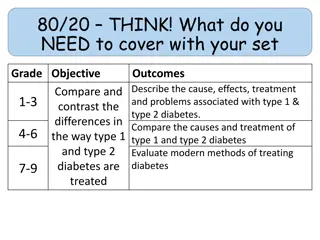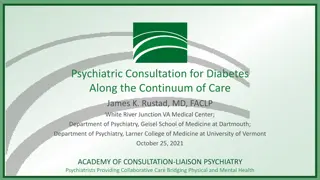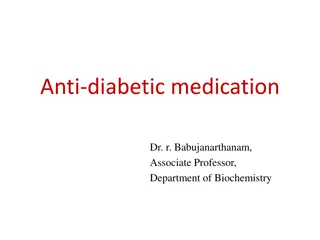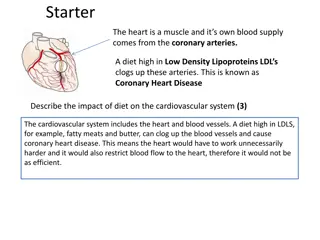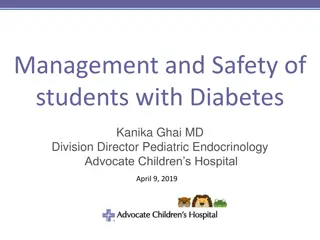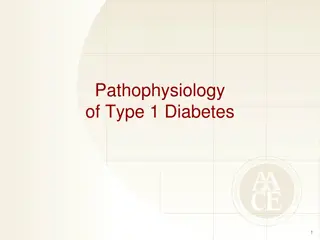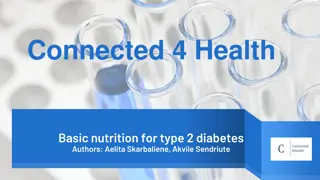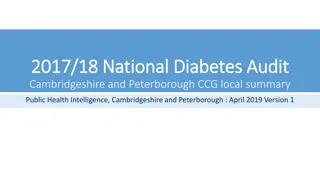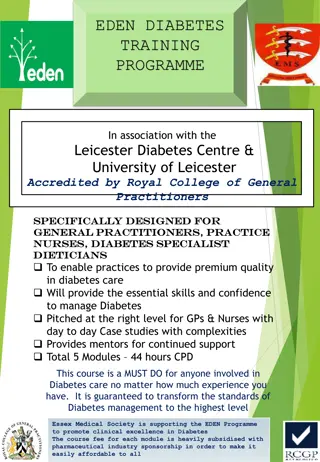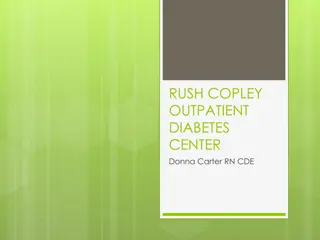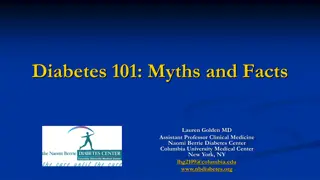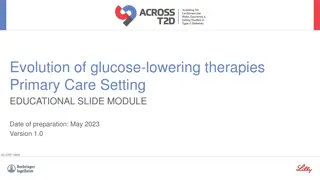Comprehensive Update on Type 2 Diabetes Management and Cardiovascular Health
This update covers key aspects of managing type 2 diabetes and addressing cardiovascular risks, including discussions on GLP-1 receptor agonists, patient safety concerns, evidence-based recommendations, and individualized therapy approaches. It also includes a patient case study highlighting the importance of lifestyle interventions in diabetes care.
Download Presentation

Please find below an Image/Link to download the presentation.
The content on the website is provided AS IS for your information and personal use only. It may not be sold, licensed, or shared on other websites without obtaining consent from the author.If you encounter any issues during the download, it is possible that the publisher has removed the file from their server.
You are allowed to download the files provided on this website for personal or commercial use, subject to the condition that they are used lawfully. All files are the property of their respective owners.
The content on the website is provided AS IS for your information and personal use only. It may not be sold, licensed, or shared on other websites without obtaining consent from the author.
E N D
Presentation Transcript
Faculty Jorge Plutzky, MD, FACC Director, Preventive Cardiology Cardiovascular Medicine Brigham and Women's Hospital Boston, Massachusetts Helena W. Rodbard, MD, FACP, MACE Past President, American Association of Clinical Endocrinologists Past President, American College of Endocrinology Founder and Medical Director, Endocrine and Metabolic Consultants Rockville, Maryland
Faculty Disclosures It is the policy of the Annenberg Center to ensure fair balance, independence, objectivity, and scientific rigor in all programming. All faculty participating in accredited programs are expected to identify and reference off-label product use and disclose any relationship with those supporting the activity or any others whose products or services are discussed. Helena W. Rodbard, MD, FACP, MACE Pacira Consultant Eli Lilly, Inversago, Medtronic, Novo Nordisk, Sanofi Research Support Bayer, Boehringer Ingelheim, Merck Speakers Bureau Jorge Plutzky, MD, FACC Consultant Altimmune, Amgen, Merck, Novartis, Novo Nordisk Research Support Boehringer Ingelheim, Novartis Speakers Bureau None
Learning Objectives Explain how the mechanisms of action of glucagon-like peptide-1 receptor agonists (GLP-1 RAs) address key pathophysiologic mechanisms of type 2 diabetes Compare and contrast the agents within the GLP-1RA class Formulate strategies to ease patient safety concerns and improve tolerability to GLP-1 RAs Justify the use of GLP-1 RAs for secondary prevention of cardiovascular disease in patients with type 2 diabetes Apply current evidence-based recommendations from the ACC, ADA, and ADA/EASD to individualize GLP-1RA therapy in patients with type 2 diabetes
Treatment of Patients With Type 2 Diabetes 2022 ADA/EASD Type 2 Diabetes Consensus Report 2023 ADA Standards of Care in Diabetes 2023 ACC/AHA Guideline for the Management of Patients With Chronic Coronary Disease
CJ: 60 yo 60 yo M, hx ASCVD, T2D, returns for cardiology follow 56 yo: PCP Overweight, HTN, prediabetes, dyslipidemia Lisinopril/HCTZ 20/25 mg/d, atorvastatin 20 mg/d BP 132/80 mmHg, BMI 31 kg/m2, A1C 6.2%, LDL 110 mg/dL, TG 220 mg/dL Patient wants to focus on lifestyle efforts, joined a gym cardiology follow- -up up
CJ: 60 yo 60 yo M, hx ASCVD, T2D, returns for cardiology follow cardiology follow- -up up 56 yo: PCP Overweight, HTN, prediabetes, dyslipidemia Lisinopril/HCTZ 20/25 mg/d, atorvastatin 20 mg/d BP 132/80 mmHg, BMI 31 kg/m2, A1C 6.2%, LDL 110 mg/dL, TG 220 mg/dL Patient wants to focus on lifestyle efforts, joined a gym 58 yo: EW, chest pain, inferior NSTEMI, SL NTG, asymptomatic Cath: RCI 90%, culprit lesion s/p drug-eluting stent; 50% LAD, no intervention
CJ: 60 yo 60 yo M, hx ASCVD, T2D, returns for cardiology follow cardiology follow- -up up 56 yo: PCP Overweight, HTN, prediabetes, dyslipidemia Lisinopril/HCTZ 20/25 mg/d, atorvastatin 20 mg/d BP 132/80 mmHg, BMI 31 kg/m2, A1C 6.2%, LDL 110 mg/dL, TG 220 mg/dL Patient wants to focus on lifestyle efforts, joined a gym 58 yo: EW, chest pain, inferior NSTEMI, SL NTG, asymptomatic Cath: RCI 90%, culprit lesion s/p drug-eluting stent; 50% LAD, no intervention 59 yo: PCP, A1C 7.5%, dx T2D, metformin initiated, BMI 32 kg/m2
CJ: 60 yo 60 yo M, hx ASCVD, T2D, returns for cardiology follow cardiology follow- -up up 56 yo: PCP Overweight, HTN, prediabetes, dyslipidemia Lisinopril/HCTZ 20/25 mg/d, atorvastatin 20 mg/d BP 132/80 mmHg, BMI 31 kg/m2, A1C 6.2%, LDL 110 mg/dL, TG 220 mg/dL Patient wants to focus on lifestyle efforts, joined a gym 58 yo: EW, chest pain, inferior NSTEMI, SL NTG, asymptomatic Cath: RCI 90%, culprit lesion s/p drug-eluting stent; 50% LAD, no intervention 59 yo: PCP, A1C 7.5%, dx T2D, metformin initiated, BMI 32 kg/m2 60 yo: Cardiology visit, asymptomatic Atorvastatin 80 mg/d, ezetimibe 10 mg/d, lisinopril/HCTZ 20/25 mg/d, metoprolol XL 50 mg/d, ASA 81 mg/d, metformin 1000 mg BID, sitagliptin 100 mg/d BP 124/80 mmHg, BMI 32 kg/m2, LDL 70 mg/dL, TG 152 mg/dL, A1C 6.9%
56 yo: PCP Overweight, HTN, prediabetes, dyslipidemia Lisinopril/HCTZ 20/25 mg, atorvastatin 20 mg 132/80, BMI 31, A1C 6.2, LDL 110, TG 220 mg/dL Patient wants to focus on lifestyle efforts, joined a gym 58 yo: EW, chest pain, inferior NSTEMI, SL nitro, asx Cath: RCI 90%, culprit lesion s/p DES; 50% LAD, no intervention 59 yo: PCP, A1C 7.5, dx T2D, metformin initiated. BMI 32 60 yo: Cardiology, asymptomatic Atorvastatin 80 mg/d, ezetimibe 10 mg/d, lisinopril/HCTZ 20/25 mg/d, metoprolol XL 50 mg/d, ASA 81 mg/d, ticagrelor, metformin 1000 mg BID, sitagliptin 100 mg/d BP 124/80 mmHg, BMI 32 kg/m2, LDL 70 mg/dL, TG 152 mg/dL, A1C 6.9%
56 yo: PCP Overweight, HTN, prediabetes, dyslipidemia Lisinopril/HCTZ 20/25 mg, atorvastatin 20 mg 132/80, BMI 31, A1C 6.2, LDL 110, TG 220 mg/dL Patient wants to focus on lifestyle efforts, joined a gym 58 yo: EW, chest pain, inferior NSTEMI, SL nitro, asx Cath: RCI 90%, culprit lesion s/p DES; 50% LAD, no intervention 59 yo: PCP, A1C 7.5, dx T2D, metformin initiated. BMI 32 60 yo: Cardiology, asymptomatic Atorvastatin 80 mg/d, ezetimibe 10 mg/d, lisinopril/HCTZ 20/25 mg/d, metoprolol XL 50 mg/d, ASA 81 mg/d, ticagrelor, metformin 1000 mg BID, sitagliptin 100 mg/d BP 124/80 mmHg, BMI 32 kg/m2, LDL 70 mg/dL, TG 152 mg/dL, A1C 6.9%
SUSTAIN-6: CVOT, Semaglutide in T2D Placebo (n=1649) Semaglutide (n=1648) Hazard ratio (95% CI) Semaglutide 0.5 mg or 1.0 mg vs placebo daily MACE 146 (8.9%) 108 (6.6%) 0.74 (0.58-0.95) 2,735 participants with T2D and high CV risk Nonfatal MI 64 (3.9%) 47 (2.9%) 0.74 (0.51-1.08) CV death 46 (2.8%) 44 (2.7%) 0.98 Primary outcome first occurrence of 3-point MACE (0.65-1.48) Nonfatal stroke 44 (2.7%) 27 (1.6%) 0.61 (0.38 to 0.99) Powered for noninferiority CI, confidence interval; CV, cardiovascular; CVD cardiovascular disease; CVOT, cardiovascular outcomes trial; HR, hazard ratio; MACE, major adverse cardiovascular events; MI, myocardial Marso SP, et al. N Engl J Med. 2016;375(19):1834-1844.
CJ: 58 yo M hx ASCVD, prediabetes, Cardiology visit post Cardiology visit post- -PCI PCI 56 yo: PCP Overweight, HTN, prediabetes, dyslipidemia Lisinopril/HCTZ 20/25 mg, atorvastatin 20 mg 132/80, BMI 31, A1C 6.2, LDL 110, TG 220 mg/dL Patient wants to focus on lifestyle efforts, joined a gym 58 yo: EW, chest pain, inferior NSTEMI, SL nitro, asx Cath: RCI 90%, culprit lesion s/p DES; 50% LAD, no intervention
CJ: 58 yo M hx ASCVD, prediabetes, Cardiology visit post Cardiology visit post- -PCI PCI 56 yo: PCP Overweight, HTN, prediabetes, dyslipidemia Lisinopril/HCTZ 20/25 mg, atorvastatin 20 mg 132/80, BMI 31, A1C 6.2, LDL 110, TG 220 mg/dL Patient wants to focus on lifestyle efforts, joined a gym 58 yo: EW, chest pain, inferior NSTEMI, SL nitro, asx Cath: RCI 90%, culprit lesion s/p DES; 50% LAD, no intervention 58 yo: Post-PCI cardiology follow-up visit. BMI 31 kg/m2, A1C 6.4%. Atorvastatin 80 mg/d, ezetimibe 10 mg/d, lisinopril/HCTZ 20/25 mg/d, metoprolol XL 50 mg/d, ASA 81 mg/d, prasugrel; LDL 70 mg/dL, BP 120/80 mmHg
SELECT: CV Efficacy Primary CV Composite Endpoint (MACE): CV Death, Nonfatal MI, or Nonfatal Stroke 10 Placebo 701 events (8.0%) Semaglutide 569 events (6.5%) Hazard ratio, 0.80 (95% CI, 0.72 to 0.90) P (two-sided) <0.001 for superiority Cumulative incidence (%) 8 6 4 Placebo 2 Semaglutide 0 0 6 12 18 24 30 36 42 48 Months since randomization Semaglutide is not indicated for reducing MACE outside of diabetes Lincoff AM, et al. N Engl J Med. 2023;389(24):2221-2232.
Davies MJ, et al. Diabetes Care. 2022;45(11):2753-2786. Davies MJ, et al. Diabetologia. 2022;65(12):1925-1966.
ElSayed NA, et al. Diabetes Care. 2023;46(Suppl 1):S140-S157.
2022 ADA/EASD Consensus Recommendations Goal: Cardiorenal Risk Reduction in High-Risk Patients With Type 2 Diabetes +CKD +CKD +HF +HF +ASCVD or High Risk +ASCVD or High Risk eGFR <60 mL/min per 1.73 eGFR <60 mL/min per 1.73 m m2 2 OR ACR >30mg/g OR ACR >30mg/g (HFrEF or HFpEF) (HFrEF or HFpEF) SGLT2i w/ primary evidence of reducing CKD progression GLP-1 RA w/ proven CVD benefit SGLT2i w/ proven HF benefit OR GLP-1 RA with proven CVD benefit if SGLT2i not tolerated or contraindicated SGLT2i w/ proven CVD benefit OR if A1C above target on SGLT2i, incorporate GLP-1 RA ASCVD, atherosclerotic cardiovascular disease; ACR, albumin-creatine ratio; HFrEF, heart failure with reduced ejection fraction; HFpEF, heart failure with preserved ejection fraction; GLP-1 RA, glucagon-like peptide-1 receptor agonist; SGLT2i, sodium glucose cotransporter 2 inhibitor Adapted from: Davies MJ, et al. Diabetes Care. 2022;45(11):2753-2786. Davies MJ, et al. Diabetologia. 2022;65(12):1925-1966.
Cardiovascular Disease and Risk Management: ADA 2023 ElSayed NA, et al. Diabetes Care. 2023;46(Suppl 1):S140-S157.
Cardiovascular Disease and Risk Management: ADA 2023 Adults w/T2D and 1 of the following: ASCVD, HF, DKD, at high risk for ASCVD Address concurrently Optimize guideline-directed medical therapy for prevention Recommend SGLT2i or GLP-1 RA with proven CV benefit (lifestyle, BP, lipids, glucose, antiplatelet) Discuss patient-clinician preferences and priorities SGLT2i selected GLP-1 RA selected No additional action Consider the addition of the alternative class, if benefits outweigh risks. Adapted from: ElSayed NA, et al. Diabetes Care. 2023;46(Suppl 1):S140-S157.
Recommendations: Using SGLT2 Inhibitors and GLP-1 RAs; AHA/ACC in CCD 2023 LOE Recommendations COR 1 A 1. In patients with CCD who have T2D, the use of either an SGLT2 inhibitor or a GLP-1 receptor agonist with proven CV benefit recommended to reduce the risk of MACE High Value B-NR 2. In patients with CCD and T2D, addition of a GLP-1 receptor agonist at US prices is projected to be of high value compared with standard of care Intermediate Value B-NR 3. In patients with CCD and T2D, addition of an SGLT2 inhibitor at US prices is projected to be of intermediate value compared with standard of care Class of Recommendation (COR) indicates the strength of recommendation, encompassing the estimated magnitude and certainty of benefit in proportion to risk Class 1 Class 1 (Strong) Benefit >>>> Risk Level of Evidence (LOE) rates quality of scientific evidence supporting the intervention based on the type, quantity, and consistency of data from clinical trials, other sources Level A: Level A: high-quality evidence >1 randomized controlled trial (RCT); meta-analysis of high-quality RCTs; one or more RCTs corroborated by high-quality registry studies Level B Level B- -NR (nonrandomized) NR (nonrandomized): moderate-quality evidence from 1 well-designed, well-executed nonrandomized studies, observational, registry studies; meta-analyses of such studies Virani SS, et al. Circulation. 2023;148(9):e9-e119.
Recommendations for Weight Management: AHA/ACC in CCD 2023 COR LOE Recommendations 1 C-EO 1. In patients with CCD, assessment of BMI with or without waist circumference is recommended during routine clinical follow-up 1 B-NR 2. Patients with CCD and overweight or obesity should receive counseling on diet, lifestyle, and goals for weight loss 2a B-R 3. For patients with CCD and overweight or obesity in whom pharmacologic therapy is warranted for further weight reduction, a GLP-1 RA can be beneficial in addition to counseling for diet and physical activity; reasonable to choose semaglutide over liraglutide Class of Recommendation (COR) indicates the strength of recommendation, encompassing the estimated magnitude and certainty of benefit in proportion to risk Class 1 Class 1 (Strong) Benefit >>>> Risk. C-EO: Consensus, Expert Opinion Level of Evidence (LOE) rates quality of scientific evidence supporting the intervention based on the type, quantity, and consistency of data from clinical trials, other sources Level A: Level A: high-quality evidence >1 randomized controlled trial (RCT); meta-analysis of high-quality RCTs; one or more RCTs corroborated by high-quality registry studies Level B Level B- -NR (nonrandomized) NR (nonrandomized): moderate-quality evidence from 1 well-designed, well-executed nonrandomized studies, observational, registry studies; meta-analyses of such studies Virani SS, et al. Circulation. 2023;148(9):e9-e119.
Which pathophysiologic mechanisms of T2D do GLP-1 RAs target?
T2D Pathophysiology DeFronzo RA. Diabetes. 2009;58(4):773-795. DeFronzo RA, et al. Nat Rev Dis Primers. 2015;1:15019.
GLP-1: Pleiotropic Physiological Effects DeFronzo RA. Diabetes Obes Metab. 2017;19:1353-1362.
Are there differences among the GLP-1 RAs with respect to glycemic effects?
Glycemic Effects: Short Glycemic Effects: Short- -Acting vs Long Acting vs Long- -Acting GLP Acting GLP- -1 RAs 1 RAs Parameters Short-Acting GLP-1 RAs Long-Acting GLP-1 RAs Exenatide BID Lixisenatide Dulaglutide Exenatide OW Liraglutide Semaglutide (injectable and oral) Compounds Fasting blood glucose levels Modest reduction Strong reduction Postprandial hyperglycemia Strong reduction Modest reduction Reduction Glucagon secretion Reduction Adapted from Table 1 of Meier, J. J. (2012). GLP-1 receptor agonists for individualized treatment of type 2 diabetes mellitus. Meier JJ. Nat Rev Endocrinol. 2012;8(12):728-742.
Are there differences among the GLP-1 RAs with respect to nonglycemic effects?
Nonglycemic Effects: Short Nonglycemic Effects: Short- -Acting vs Long Acting vs Long- -Acting GLP Acting GLP- -1 RAs 1 RAs Parameters Short-Acting GLP-1 RAs Long-Acting GLP-1 RAs Exenatide BID Lixisenatide Dulaglutide Exenatide OW Liraglutide Semaglutide (injectable and oral) Compounds Gastric emptying rate Deceleration No effect [or modest deceleration] Heart rate No effect or small increase (0 to 2 bpm) Moderate increase (2 to 5 bpm) Body weight reduction 1 to 5 kg 2 to 5[+] kg Systolic blood pressure Modest reduction (-1.4 mmHg) Lipids Modest reduction: LDL-C 3.094 mg/dL | TC 5.03 mg/dL | TG 0.886 mg/dL Adapted from Table 1 of Meier, J. J. (2012). GLP-1 receptor agonists for individualized treatment of type 2 diabetes mellitus. Meier JJ. Nat Rev Endocrinol. 2012;8(12):728-742. Diallo A., et al. Acta Diabetol. 60(12):1651-1662. Berberich AJ, et al. Curr Opin Lipidol. 2021;32(3):191-199. Sun F, et al. Clin Ther. 2015;37(1):225-241.e8. Cornell S. J Clin Pharm Ther. 2020;45(S1):17-27. Htike ZZ, et al. Diabetes Obes Metab. 2017;19(4):524-536. Monami M, et al. Diabetes Obes Metab. 2014;16(1):38-47.
Tirzepatide: Dual GLP-1 RA + GIP Characteristics Mechanism of Action GLP-1 RA and glucose-dependent insulinotropic polypeptide (GIP) receptor that increases glucose-dependent insulin secretion, decreases inappropriate glucagon secretion, and slows gastric emptying Labeled Indications As an adjunct to diet and exercise to improve glycemic control in adults with type 2 diabetes mellitus Dosing Subcutaneous: Initial: 2.5 mg once weekly x 4 wks, then increase to 5 mg once weekly. Maximum dose: 15 mg/wk Bailey CJ. Lancet Diabetes Endocrinol. 2021;9(10):646-648. Mounjaro (tirzepatide) [prescribing information]. Indianapolis, IN: Lilly USA LLC; September 2023.
Does it matter which GLP-1 RA is used in a patient with T2D and ASCVD/high risk?
GLP-1 RAs With Proven CVD Benefits: FDA Indications GLP-1 RA FDA CVD Indication Liraglutide Risk reduction of major cardiovascular events (cardiovascular death, nonfatal myocardial infarction, nonfatal stroke) in adults with T2D and established CVD Semaglutide (injectable) Dulaglutide Risk reduction of major cardiovascular events (cardiovascular death, nonfatal myocardial infarction, nonfatal stroke) in adults with T2D who have established CVD or multiple CV risk factors Victoza (liraglutide) [prescribing information]. Plainsboro, NJ: Novo Nordisk Inc; July 2023. Ozempic (semaglutide) [prescribing information]. Plainsboro, NJ: Novo Nordisk Inc; September 2023. Trulicity (dulaglutide) [prescribing information]. Indianapolis, IN: Eli Lilly and Company; April 2023.
Meta Meta- -analysis: GLP analysis: GLP- -1 RA CVOTs in T2D, High CVD Risk 1 RA CVOTs in T2D, High CVD Risk GLP-1 Receptor Agonist, n/N (%) Placebo n/N (%) Hazard Ratio (95% CI) NNT (95% CI) P Value Weights are from random effect analysis. In addition to primary cardiovascular outcome results papers, data were extracted from additional sources. AMPLITUDE-O data were provided by the authors. Three-point MACE consisted of cardiovascular death, myocardial infarction, and stroke. NNTs were calculated over a weighted average median follow-up of 3.0 years. P values are for superiority 3-point MACE ELIXA (lixisenatide) 400/3034 (13%) 392/3034 (13%) 1.02 (0.89, 1.17) .78 Efpeglenatide not FDA-approved. Not all agents and formulations are indicated for cardiovascular risk reduction. LEADER (liraglutide) 608/4668 (13%) 694/4672 (15%) 0.87 (0.78, 0.97) .01 CVOT, cardiovascular outcomes trial; MACE, major adverse cardiovascular event; NNT, number needed to treat. SUSTAIN-6 (semaglutide SQ) 108/1648 (7%) 146/1649 (9%) 0.74 (0.58, 0.95) .016 Sattar N, et al. Lancet Diabetes Endocrinol. 2021;9:653-662. EXSCEL (exenatide OW) 839/7356 (11%) 905/7396 (12%) 0.91 (0.83, 1.00) .061 Harmony Outcomes (albi NA) 338/4731 (7%) 428/4732 (9%) 0.78 (0.68, 0.90) .0006 REWIND (dulaglutide) 594/4949 (12%) 663/4952 (13%) 0.88 (0.79, 0.99) .026 PIONEER 6 (oral semaglutide) 61/1591 (4%) 76/1592 (5%) 0.79 (0.57, 1.11) .17 AMPLITUDE-O (investigational) 189/2717 (7%) 125/1359 (9%) 0.73 (0.58, 0.92) .0069 Subtotal (I2 = 44.5%, P = .082) 1 0.5 1.5 0.86 (0.80, 0.93) 65 (45, 130) < .0001 Favors placebo Favors GLP-1 RA Weights are from random effect analysis. In addition to primary cardiovascular outcome results papers, data were extracted from additional sources. AMPLITUDE-O data were provided by the authors. Three-point MACE consisted of cardiovascular death, myocardial infarction, and stroke. NNTs were calculated over a weighted average median follow-up of 3.0 years. P values are for superiority. Efpeglenatide not FDA-approved. Not all agents and formulations are indicated for cardiovascular risk reduction. CVOT, cardiovascular outcomes trial; MACE, major adverse cardiovascular event; NNT, number needed to treat. Sattar N, et al. Lancet Diabetes Endocrinol. 2021;9:653-662.
Does it matter which GLP-1RA is used in a patient with T2D and CKD who is not a candidate for SGLT-2i therapy?
Recommended GLP-1 RAs in CKD GLP-1 RA FDA CVD Indication Liraglutide Risk reduction of major cardiovascular events (cardiovascular death, nonfatal myocardial infarction, nonfatal stroke) in adults with type 2 diabetes mellitus and established cardiovascular disease Semaglutide (injectable) Dulaglutide Risk reduction of major cardiovascular events (cardiovascular death, nonfatal myocardial infarction, nonfatal stroke) in adults with type 2 diabetes mellitus who have established cardiovascular disease or multiple cardiovascular risk factors Victoza (liraglutide) [prescribing information]. Plainsboro, NJ: Novo Nordisk Inc; July 2023. Ozempic (semaglutide) [prescribing information]. Plainsboro, NJ: Novo Nordisk Inc; September 2023. Trulicity (dulaglutide) [prescribing information]. Indianapolis, IN: Eli Lilly and Company; April 2023. ElSayed NA, et al. Diabetes Care. 2023;46(Suppl 1):S140-S157.
Meta-Analysis GLP-1 RA CVOTs Composite kidney outcome including macroalbuminuria Composite kidney outcome including macroalbuminuria GLP-1 Receptor agonist, n/N (%) Placebo n/N (%) Hazard ratio (95% CI) NNT (95% CI) P value Composite kidney outcome including macroalbuminuria ELIXA (lixisenatide) 172/2647 (6%) 203/2639 (8%) 0 84 (0 68-1 02) 0 083 LEADER (liraglutide) 268/4668 (6%) 337/4672 (7%) 0 78 (0 67-0 92) 0 003 SUSTAIN-6 (semaglutide SQ) 62/1648 (4%) 100/1649 (6%) 0 64 (0 46-0 88) 0 005 EXSCEL (exenatide OW) 366/6256 (6%) 407/6222 (7%) 0 88 (0 76-1 01) 0 065 REWIND (dulaglutide) 848/4949 (17%) 970/4952 (20%) 0 85 (0 77-0 93) 0 0004 AMPLITUDE-O (investigational) 353/2717 (13%) 250/1359 (18%) 0 68 (0 57-0 79) <0 0001 Subtotal (I =47 5%, P=0 090) 0 79 (0 73-0 87) 47 (37-77) <0 0001 0.5 1 1.5 Favours GLP-1 receptor agonists Favours placebo Weights are from random effect analysis. In addition to primary cardiovascular outcome results papers, data were extracted from additional sources. AMPLITUDE-O data were provided by the authors. Data on kidney outcomes were not available in Harmony outcomes and PIONEER 6. The composite kidney outcome consisted of development of macroalbuminuria, doubling of serum creatinine or at least 40% decline in eGFR, kidney replacement therapy, or death due to kidney disease; for ELIXA, data are for new-onset macroalbuminuria alone NNTs were calculated over a weighted average median follow-up of 3.4 years. CI, confidence interval; CVOTs. cardiovascular outcome trials; GLP-1, glucagon-like peptide-1; GLP-1 RAs, GLP-1 receptor agonists; NNT, number needed-to-treat Sattar N, et al. Lancet Diabetes Endocrinol. 2021;9:653-662.
Rossing P, et al. Nephrol Dial Transplant. 2023;38(9):2041-2051.
What education should be provided to address patient concerns related to GLP-1 RA therapy?
GLP-1 RAs: Contraindications & Warnings History of serious hypersensitivity reaction to drug History of pancreatitis debated given more trial data (SELECT) Pregnancy or breastfeeding Personal or family history of medullary thyroid cancer Personal or family history of multiple endocrine neoplasia, type 2 (MEN2) Das SR, et al. J Am Coll Cardiol. 2020;76(9):1117-1145.
Considerations for Patient Concerns Diabetic retinopathy complications have been reported, perhaps due to rapid improvement in blood glucose control Advise patients to undergo appropriate, guideline-recommended eye exams before starting therapy if not done within the last 12 months Inform patients regarding prescription assistance programs Das SR, et al. J Am Coll Cardiol. 2020;76(9):1117-1145.
Considerations for Drug Initiation & Monitoring Stop DPP-IV inhibitor before initiation Hypoglycemia risk increased with insulin and sulfonylureas If history of frequent hypoglycemic events, stop sulfonylurea and reduce insulin dose by ~20% when starting therapy Das SR, et al. J Am Coll Cardiol. 2020;76(9):1117-1145.
What are common GLP-1 RA side effects?
Adverse Effects to Monitor, Anticipate for Patient Gastrointestinal: Nausea/vomiting Diarrhea Improves with diet adjustments, drug exposure, slow titration, reverse titration as needed Nongastrointestinal: Hypoglycemia when given with insulin or sulfonylureas Injection site reactions Das SR, et al. J Am Coll Cardiol. 2020;76(9):1117-1145.
What education should be provided so that patients optimize treatment with GLP-1 RA therapy?
Recommendations to Minimize Occurrence + Severity of GI Adverse Effects with GLP-1 RAs Improve eating habits: Eat slowly Eat only if you are hungry Eat smaller portions Avoid lying down after having a meal Stop eating in case of feeling of fullness Pay attention to the impact of certain foods Gorgojo-Mart nez JJ, et al. J Clin Med. 2022;12(1):145.
Recommendations to Minimize Occurrence and Severity of GI Adverse Effects with GLP-1 RAs Additional recommendations for patients with nausea Wait 30 min since GLP-1RA dose eat foods to ease nausea, if needed Crackers, apples, ginger root/ginger-based drinks Avoid strong smells Additional recommendations for patients with vomiting Attentive to hydration Eat smaller amounts of food more frequently Gorgojo-Mart nez JJ, et al. J Clin Med. 2022;12(1):145.
Does dosing need to be adjusted based on kidney function?
ADA/KDIGO: GLP-1 RA Dosing for eGFR <45 eGFR <45 Dual GIP + GLP-1RA No dose adjustment required Tirzepatide de Boer IH, et al. Diabetes Care. 2022;45(12):3075-3090.
How might the cardiologist collaborate with the multidisciplinary, interprofessional care?





